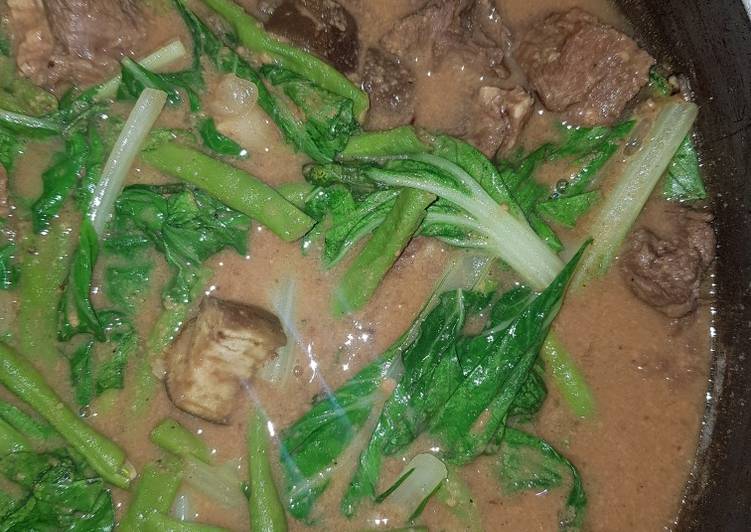
Hello everybody, it is John, welcome to my recipe page. Today, we’re going to make a distinctive dish, beef kare-kare. It is one of my favorites. This time, I will make it a bit unique. This is gonna smell and look delicious.
Beef Kare-Kare is one of the most well liked of recent trending meals on earth. It’s enjoyed by millions daily. It’s easy, it is quick, it tastes delicious. They are fine and they look wonderful. Beef Kare-Kare is something that I have loved my entire life.
Beef Kare-Kare is a version of kare-kare or peanut stew that makes use of beef chuck, instead of the traditional oxtail. It is as good as our other versions of kare kare. It was perfect with some spicy shrimp paste.
To begin with this recipe, we must prepare a few ingredients. You can have beef kare-kare using 14 ingredients and 5 steps. Here is how you cook it.
Ingredients
The ingredients needed to make Beef Kare-Kare:
- Take 1 kilo beef cut into cubes
- Get 100 g Bok Choy (Chinese cabbage) cut
- Get 100 g yardlong beans cut into 2 inch long
- Prepare 4 eggplants sliced/cut
- Prepare 3 cups water
- Get 1 cup ground peanuts or 5 tablespoons creamy peanut butter
- Get 1 tablespoon fish sauce
- Make ready 1 tablespoon cornstarch dissolved in 3 tablespoons warm water
- Prepare 1 medium sized onion diced
- Prepare 5 cloves garlic minced
- Make ready to taste Salt and pepper
- Make ready Cooking oil
- Take Shrimp paste/bagoong
- Get Optional: 3 tbs annatto seeds soaked in a cup of water for colour
Images of the sautéed shrimp paste (bagoong), banana blossom flower and 'astuete' seeds are included in the Recipe Introduction. This dish is another variation of Oxtail Kare-Kare, it makes use of beef chunks complemented with various vegetables and of course peanut. This Filipino Kare-Kare Recipe is a meat and vegetable stew with oxtail, beef or tripe, eggplant, banana buds, pechay, string beans, and other vegetables that mainly flavored with a sweet and savory peanut sauce. Kare-Kare is a well- known dish from Pampanga aptly hailed as the Culinary Capital of the Philippines.
Instructions
Instructions to make Beef Kare-Kare:
- Saute garlic and onion in oil until garlic is light golden brown and onion is translucent. Set aside.
- Using the same pan earlier, cook beef for about 30-45 minutes or until tender. Push beef to the side of the pan and add sliced eggplants. Fry for about 5 minutes.
- Add cooked garlic and onion, pour in 3 cups water (if using annatto seeds, replace 1 cup of water used to doak seeds in) and dissolved cornstarch and bring to a boil. Add ground peanuts/peanut butter, fish sauce, salt and pepper to taste. Simmer for about 10-15 minutes until sauce thickens.
- Add yardlong beans and bok choy/pechay and simmer for another 5 minutes. Remove from heat. Note: Some prefer to blanch their veggies in hot water to cook separately from the meat and sauce to retain crispiness of vegetables.
- Serve over steamed rice and a little bit of bagoong/shrimp paste on the side.
Its name derived from the word "Kari" from the word "curry". Beef Kare-Kare is a version of kare-kare or peanut stew that makes use of beef chuck, instead of the traditional oxtail. It is as good as our other versions of kare kare. It was perfect with some spicy shrimp paste. Meat variants may include goat meat, chicken or rarely fish.
So that’s going to wrap this up with this exceptional food beef kare-kare recipe. Thank you very much for reading. I’m sure that you will make this at home. There’s gonna be interesting food at home recipes coming up. Don’t forget to bookmark this page in your browser, and share it to your loved ones, colleague and friends. Thank you for reading. Go on get cooking!
Print this page

